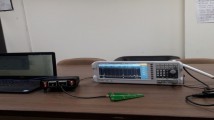Abstract
In the current scenario path loss, coverage and capacity by operating network under fading condition is research challenge. In this paper, signal strength of long term evolution network operating at 1.8 GHz is recorded for analysis. During the measurement, the range of received signal strength varies in between − 72 and − 104 dBm for basement data transmission. The variation of received signal at 12 distinct points in the basement was marked sincerely. Based on this received signal the link budget is formulated and presented. The capacity of a network on given link budget is calculated and verified. The data recorded for such environment using spectrum analyzer and simulating with Matlab is presented. The behaviour of signal referred to a value of path loss exponent i.e. 4.55. The path loss exponent provides the real coverage under urban area in fading condition. Using different models of prediction, real path loss under fading is calculated and based upon this path loss value a model is proposed for next generation networks.








Similar content being viewed by others
References
Alqudah, Y. A. (2012). Path loss modeling based on field measurements using deployed 3.5 GHz WiMAX network. Wireless Personal Communication, 69, 793–803.
Kazi, B. U., & Wainer, G. A. (2019). Next generation wireless cellular networks: Ultra-dense multi-tier and multi-cell cooperation perspective. Wireless Networks, 25, 2041–2064.
Liu, G. Y., Chang, T. Y., Chiang, Y. C., Lin, P. C., & Mar, J. (2017). Path loss measurements of indoor LTE system for the internet of things. Applied Sciences, 7(6), 537. https://doi.org/10.3390/app7060537.
Ahmed, B. T., Campos, J. L. M., & Mayordomo, J. M. L. (2012). Propagation path loss and materials insertion loss in indoor environment at WiMax band of 3.3–3.6 GHz. Wireless Personal Communication, 66, 251–260.
Elechi, P., & Otasowie, P. O. (2016). Comparison of empirical path loss propagation models with building penetration path loss models. International Journal on Communications Antenna and Propagation, 6(2), 116–123.
Athanasiadou, G., Tsoulos, G., Zarbouti, D., & Valavanis, I. (2019). Optimizing radio network planning evolution towards microcellular systems. Wireless Personal Communications, 106, 521–534.
Sharma, S., & Singh, B. (2013). WiMAX network for capacity and coverage assessment. Wireless Personal Communications, 75(2), 1573–1586.
Sharma, S., & Singh, B. (2013). Experimental study of a fixed WiMAX network at 2.62 GHz. Wireless Personal Communications, 72(4), 2127–2141.
Ibrahim, A., Alsharekh, M., Almanee, M., Al-Turki, A., & Islam, M. (2019). Link budget design for RF line-of-sight via theoretical propagation prediction. International Journal of Communications, Network and System Science, 12(1), 11–17.
Kashif, M., Khan, N., & Altalbe, A. (2020). Hybrid optical-radio transmission system link quality: link budget analysis. IEEE Access, 8, 65983–65992.
Karamyshev, A., Khorov, E., Krasilov, A., & Akyildiz, I. F. (2020). Fast and accurate analytical tools to estimate network capacity for URLLC in 5G systems. Computer Networks, 178, 107331. https://doi.org/10.1016/j.comnet.2020.107331.
Tlebaldiyeva, L., Maham, B., & Tsiftsis, T. A. (2020). Capacity analysis of device-to-device mmWave networks under transceiver distortion noise and imperfect CSI. IEEE Transactions on Vehicular Technology, 69(5), 5707–5712.
Yadav, P., & Agrawal, R. (2019). Network selection for maximum coverage using regression analysis in deep fading environment. Wireless Personal Communication, 106(3), 1057–1074.
Sreedevi, A. G., Rao, T. R., & Susila, M. (2019). Measurements at 2.4, 3.4, 5.2, 28 and 60 GHz for device-to-device wireless communications. Wireless Personal Communications, 108(3), 1733–1743.
Atanasov, P., & Kiss’ovski, Z. (2017). Optimization of path loss models based on signal level measurements in 4G LTE network in Sofia. Bulgarian Journal of Physics, 44(2), 145–154.
Sharma, P. K., Sharma, D., Sau, P. C., & Gupta, A. (2016). Comparative analysis of propagation models in LTE networks with spline interpolation. In International conference on communication control and intelligent systems (CCIS 2016), Mathura, India.
Cabuk, U. C., & Dalkilic, G. (2018). A path loss analysis on LTE radio in Eastern Market Districts. In International conference on artificial intelligence and data processing (IDAP 2018), Malatya, Turkey.
Ahuja, K., Singh, B., & Khanna, R. (2014). Network selection algorithm based on link quality parameters for heterogeneous wireless network. Optik, 125(14), 3657–3662.
Ramkumar, J., & Gunasekaran, R. (2013). A new path loss model for LTE network to address propagation delay. International Journal of Computer and Communication Engineering, 2(4), 413–416.
Hu, H., Zhang, J., Zheng, X., Yang, Y., & Wu, P. (2010). Self-configuration and self optimization for LTE networks. IEEE Communications Magazine, 48(2), 94–100.
Obeidat, H. A., Asif, R., Ali, N. T., Dama, Y. A., Obeidat, O. A., Jones, S. M. R., et al. (2018). An indoor path loss prediction model using wall correction factors for wireless local area network and 5G indoor networks. Radio Science, 53, 544–564.
Swain, C. M. K., & Das, S. (2017). Estimation of path loss model for a 2.65 GHz mobile WiMAX network deployed in a sub-urban environment with regression techniques. Wireless Personal Communications, 99, 283–297.
Seidel, S. Y., & Rappaport, T. S. (1992). 914 MHz path loss prediction models for Indoor wireless communications in multifloored buildings. IEEE Transactions on Antennas and Propagation, 40(2), 207–217.
Hoomod, H. K., Mejibli, I. A., & Jabboory, A. I. (2018). Analyzing study of path loss propagation models in wireless communications at 0.8 GHz. Journal of Physics: Conference Series, 1003, 1–7. https://doi.org/10.1088/1742-6596/1003/1/012028.
Wang, Y., Wang, X. L., Qin, Y., Liu, Y., Lu, W. J., & Zhu, H. B. (2014). An empirical path loss model in the indoor stairwell at 2.6 GHz. In IEEE International wireless symposium (IWS 2014) (pp. 1–4). https://doi.org/10.1109/ieee-iws.2014.6064218.
Rappaport, T. S. (2007). Wireless communications (2nd ed.). New Delhi: PHI.
MATLAB and Statistics Toolbox Release (2017b). The MathWorks, Inc., Natick, Massachusetts, United States.
Goldsmith, A. (2005). Wireless communications. Cambridge: Cambridge University Press.
Author information
Authors and Affiliations
Corresponding author
Additional information
Publisher's Note
Springer Nature remains neutral with regard to jurisdictional claims in published maps and institutional affiliations.
Rights and permissions
About this article
Cite this article
Yadav, P., Maheshwari, K., Lal, A.K. et al. Network Planning for Deep Fading Area at 1.8 GHz LTE Network. Wireless Pers Commun 116, 2223–2237 (2021). https://doi.org/10.1007/s11277-020-07788-z
Published:
Issue Date:
DOI: https://doi.org/10.1007/s11277-020-07788-z




